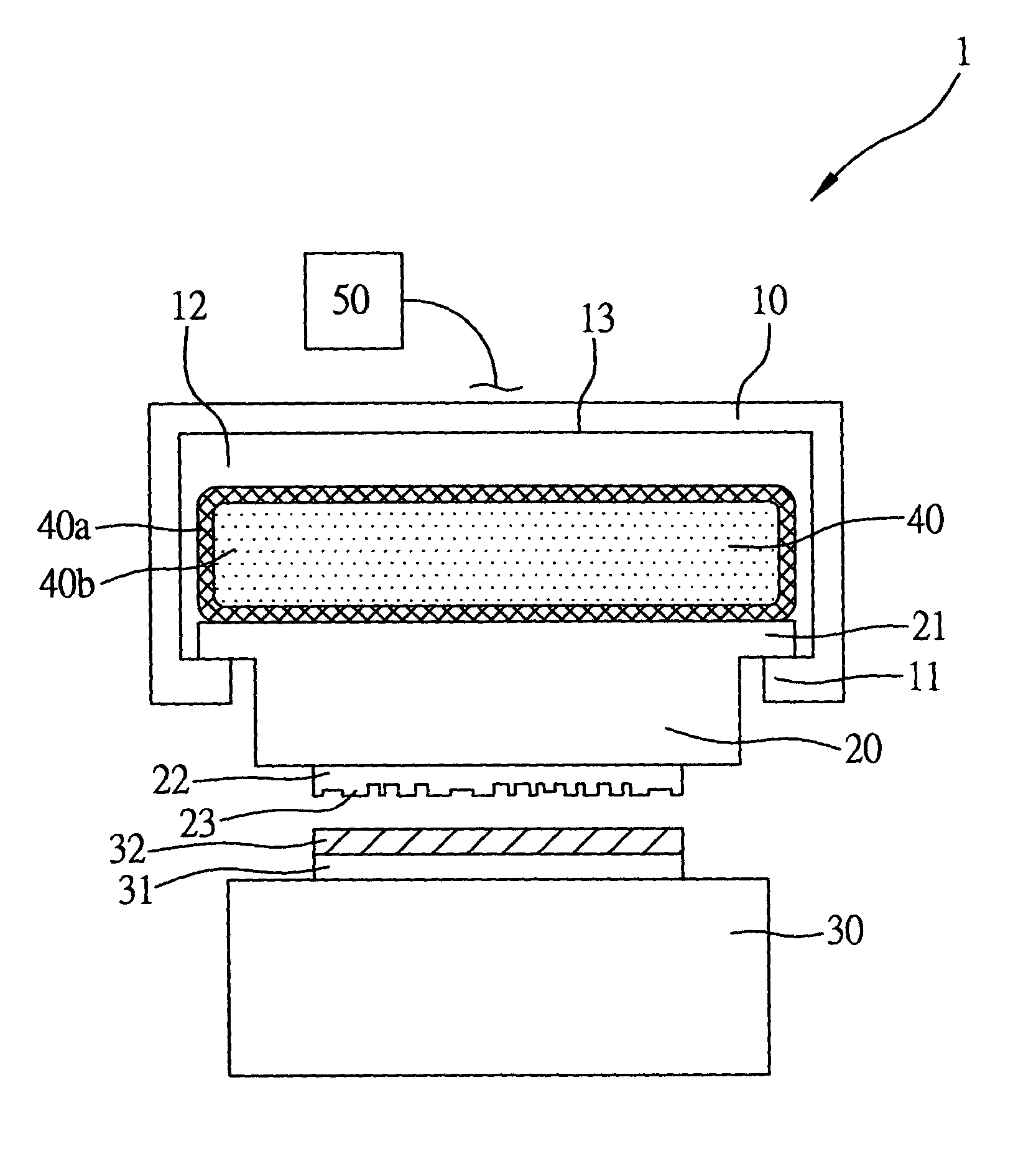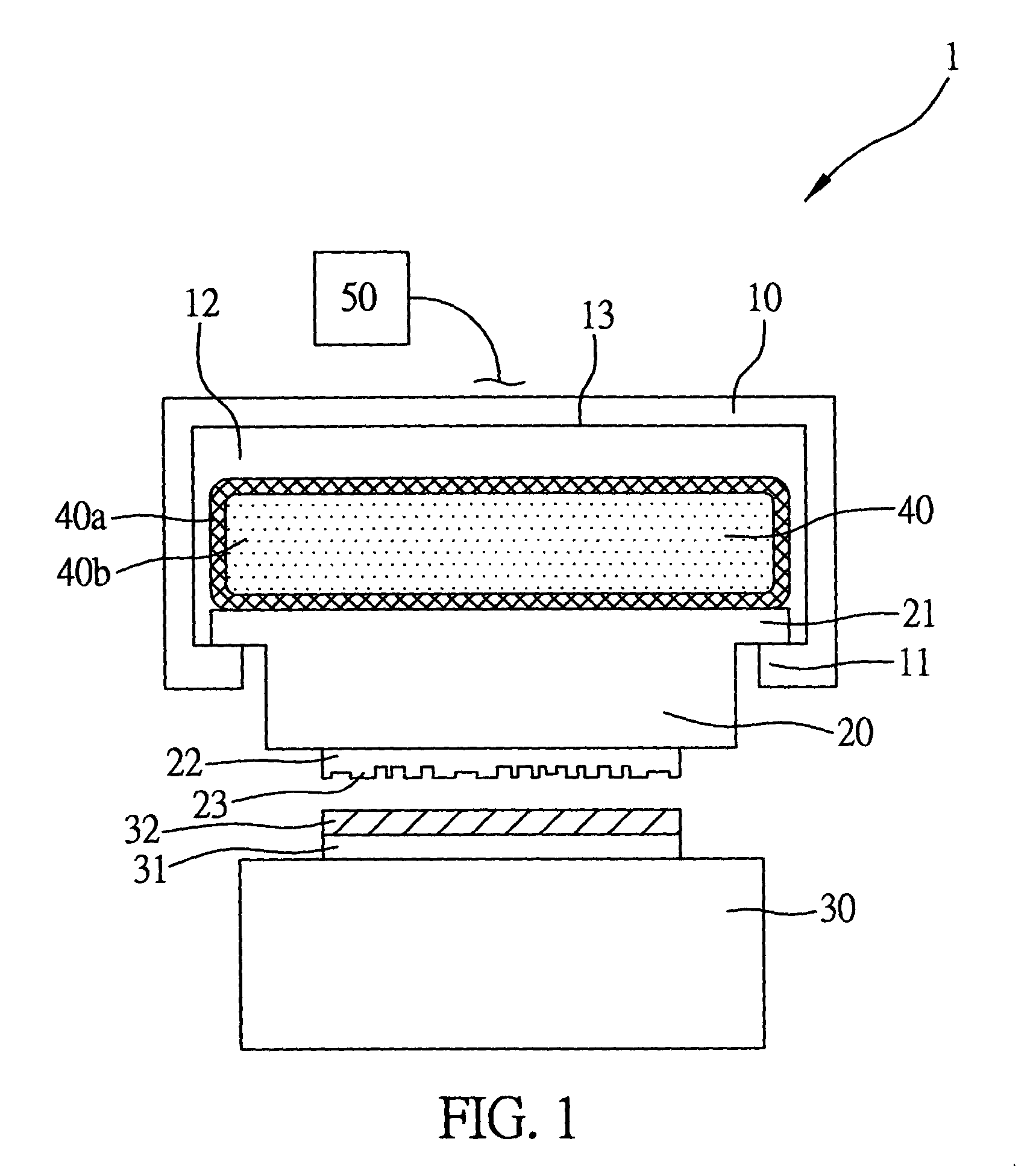Uniform pressing apparatus
a pressing apparatus and uniform technology, applied in the field of uniform pressing apparatus, can solve the problems of poor design, degraded molding quality and manufacturing efficiency in mass production, and limited processing technology, and achieve good parallelism
- Summary
- Abstract
- Description
- Claims
- Application Information
AI Technical Summary
Benefits of technology
Problems solved by technology
Method used
Image
Examples
first embodiment
[0035]FIG. 2A through to FIG. 2D illustrate the operation of a uniform pressing apparatus according to the invention. Referring to FIG. 2A, a substrate 31 is subjected to a horizontal alignment with a mold 22. Referring to FIG. 2B, the power source 50 drives the housing 10, along with the first carrier unit 20 and the mold 22 to move toward the substrate 31 on the second carrier unit 30. Thereby, the nanoscale feature 23 on the mold 22 makes a contact with a moldable layer 32. Since the first flange 11 makes free contact with the second flange 21, the mold 22 and the substrate 31 are not restrained to each other when the mold 22 makes the contact with the substrate 31. Therefore, an optimal parallelism is achieved at the moment when the contact is made. As shown in FIG. 2B, the second flange 21 is detached from the first flange 11 as a result of a counteracting force that acts on the second flange 21 to push the second flange 21 away from the first flange 11. The housing 10 is still...
second embodiment
[0036]FIG. 3A through to FIG. 3D illustrate the operation of a uniform pressing apparatus according to the invention. Similarly, the invention includes a housing 10, a first carrier unit 20, a uniform pressing unit 40, a second carrier unit 40 and a power source 50. The power source 50 is mounted alongside the second carrier unit 30 to drive movement of the second carrier unit 30 towards the first carrier unit 20. The power source 50 further provides an imprint force, so that the imprinting process is carried out via the contact formed as a result of the substrate moving towards the nanoscale features. The substrate 31 is subjected to a horizontal alignment with the mold 22 as shown in FIG. 3A. The power source 50 drives the second carrier unit 30 and the substrate 31 on the second carrier unit 30 to move toward the first carrier unit 20 and the mold 22 on the first carrier unit 20, as shown in FIG. 3B. The first flange 11 makes a free contact with the second flange 21 to achieve op...
third embodiment
[0037]FIG. 4A through to FIG. 4D illustrate the operation of a uniform pressing apparatus according to the invention. Similarly, the invention includes a housing 10, a first carrier unit 20, a second carrier unit 30, a uniform pressing unit 40, and a power source 50. In this embodiment of the invention, the power source 50 includes a feeding power source 50a and an imprint power source 50b. The feeding power source 50a drives the housing 10 to move toward the second carrier unit 30, while the imprint power source 50b drives the uniform pressing unit 40 to exert pressure. The substrate 31 and the mold 22 are subjected to a horizontal alignment as shown in FIG. 4A. The feeding power source 50a drives the housing 10 to move downward along with the first carrier unit 20 and the mold 22. The first flange 11 makes the free contact with the second flange 21 to achieve optimal parallelism between the substrate 31 and the mold 22 when the substrate 31 makes the contact with the mold 22. Refe...
PUM
| Property | Measurement | Unit |
|---|---|---|
| Force | aaaaa | aaaaa |
| Pressure | aaaaa | aaaaa |
| Electromagnetism | aaaaa | aaaaa |
Abstract
Description
Claims
Application Information
 Login to View More
Login to View More - R&D
- Intellectual Property
- Life Sciences
- Materials
- Tech Scout
- Unparalleled Data Quality
- Higher Quality Content
- 60% Fewer Hallucinations
Browse by: Latest US Patents, China's latest patents, Technical Efficacy Thesaurus, Application Domain, Technology Topic, Popular Technical Reports.
© 2025 PatSnap. All rights reserved.Legal|Privacy policy|Modern Slavery Act Transparency Statement|Sitemap|About US| Contact US: help@patsnap.com



